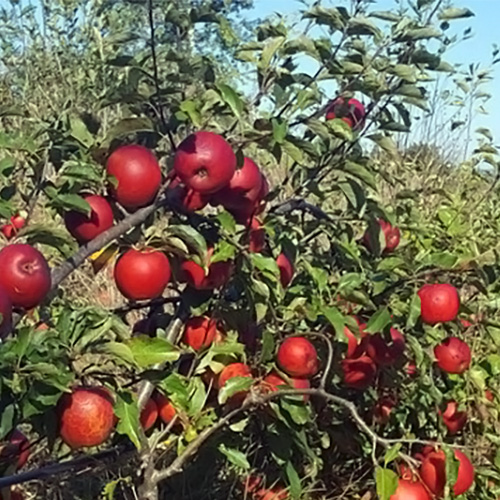
Williams Pride Apple Tree
Origin: USA
Description:The Williams Pride Apple Tree is an early season variety known for its resistance to both apple scab and mildew, making it a popular choice for organic orchards. It has a strong, upright growth habit, with dark green foliage that provides a beautiful contrast to its dark red fruits. This variety was developed in the United States as part of a disease-resistant breeding program and is well-suited to a wide range of climates.
Fruit: The apples are medium-sized with a striking deep red skin, almost purple at full maturity. The flesh is crisp, juicy, and has a balanced sweet-tart flavor with subtle spicy undertones, making it excellent for eating fresh as well as for cooking and baking.
Harvest: Fruits mature early in the season, with harvest times starting in late July to early August. The early ripening allows for an extended selling period before many other apple varieties come to market.
Pollination: Williams Pride is a self-fertile variety but benefits from cross-pollination with other apple varieties such as Jonathan, Golden Delicious, or McIntosh to enhance fruit set and yield.
Spacing: Recommended spacing for semi-dwarf trees is about 3 to 4 meters between trees, allowing adequate room for growth and air circulation, while dwarf trees should be spaced approximately 2 to 3 meters apart. Semi-dwarf trees can reach a height of up to 3.5 meters, whereas dwarf trees typically grow up to 2.5 meters.
Good to know: Williams Pride is not only favored for its early harvest and disease resistance but also for its ability to adapt to different soil types and conditions. It is also known for its consistent production and good fruit quality in various climates.
ask prices
- We only sell bare root trees to countries in Europe. We can't export potted trees due to trade regulations.
- We can deliver the trees to all countries in Europe and some countries in Eurasia and Middle East. We can arrange a truck to deliver the trees to your country.
- We are a wholesale nursery. Our minimum order quantity is 3.000 trees. Please note that we don't take orders below this limit.
- Phytosanitary certificates are provided with all orders. These certificates prove the origin of the trees and certify that they are free of diseases.
MM 9 (Dwarf)
M 9 is a dwarf rootstock suitable for high-density planting. It is resistant to the crown rot disease and moderately sensitive to the fire blight and wooly aphid. It is resistant to the illness of the tree tree and mildly susceptible to the blight of flames and wooly aphid. Throughout cultivation, it requires support systems. It should not be grafted on spur-type varieties such as Scarlett Spur, Redchief and Starkspur Golden. For the field, it should be recommended without limiting watering. It is moderately resistant to calcareous and heavy-textured soils. High crop quality, early fruit bearing and elevated efficiency out of a unit region within a brief span of moment are the most advantageous features M 9 offers to the plants.
MM 106 (Middle size)
It is a semi-dwarf rootstock, resistant to wooly aphid and is highly sensitive to disease of crown rot. For heavy-textured and argillaceous soils, it should certainly not be suggested. It has a closer and heavier root structure than rootstocks M9 and M26. Although it is more resistant to the climate than rootstocks M9 and MM 26, it should be chosen for frequent watering plants.For the gardens where MM 106 is grown, support devices are not needed. Within three or four years after planting, it becomes commercially profitable.
MM 111 (Large)
It is a semi-dwarf rootstock bigger than M106 and smaller than standard seedling rootstock. It is resistant to the illness of crown rot, wooly aphid and heavy-textured, argillaceous, calcareous plants with a pH scale above 7. Depending on the circumstances of care, it becomes commercially profitable within four or five years. When early flowering is desired, M 9 may be recommended as the rootstock between the system in some cases. When grafted on spur form and low strength varieties, it provides stronger outcomes.






